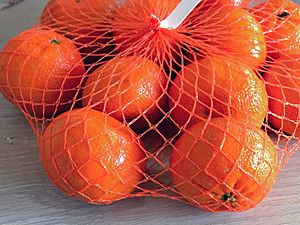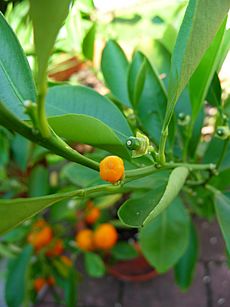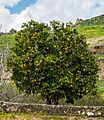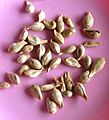Mandarin orange facts for kids
Quick facts for kids Mandarin orange |
|
|---|---|
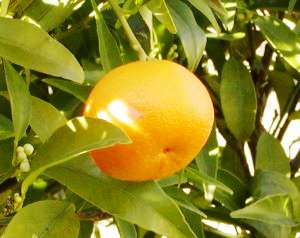 |
|
| Scientific classification | |
| Kingdom: | |
| (unranked): | |
| (unranked): | |
| (unranked): | |
| Order: | |
| Family: | |
| Genus: | |
| Species: |
C. reticulata
|
| Binomial name | |
| Citrus reticulata |
|
The Mandarin orange, often just called a mandarin, is a small citrus tree. Its fruit looks a lot like other oranges. People usually eat mandarin oranges by themselves or add them to fruit salads.
Mandarin trees are sensitive to cold weather. They grow best in warm places like tropical and subtropical regions.
It's super easy to peel a mandarin with your fingers. You can also split it into neat segments without making a mess. This makes mandarins a convenient snack because you don't need any forks or knives to eat them. You can even buy mandarin segments in cans!
During Chinese New Year, mandarin oranges and tangerines are important symbols. They represent good luck and fortune. People often use them as decorations and give them as gifts to friends and family during the two-week celebration.
Contents
About the Mandarin Tree
The Citrus reticulata is a medium-sized tree. It usually grows up to 4 meters (13 feet) tall. However, an older tree, around 30 years old, can reach 5 meters (16 feet). A large, healthy tree can produce thousands of fruits! Mandarin trees often have small thorns.
The leaves of the mandarin tree are shiny and green. They are usually quite small. The stems that connect the leaves to the branch are short. They might have tiny, almost invisible, wings.
Mandarin flowers grow alone or in small groups. They appear where the leaves meet the branches.
How Mandarin Trees Reproduce
Most citrus trees can fertilize themselves. This means they only need a bee to move pollen within the same flower. Some varieties, like the satsuma, don't even need pollination. They produce fruit without seeds.
One type of mandarin, called the Dancy cultivar, is different. Its flowers cannot fertilize themselves. They need pollen from another type of mandarin tree. They also need many bees to help them produce a good crop of fruit.
What Mandarin Fruit is Like
Mandarin orange fruits are small, usually 4 to 8 centimeters (about 1.5 to 3 inches) across. Their color can be orange, orange-yellow, or even orange-red. They are shaped like a ball, but often a bit flattened at the top and bottom.
The skin of a mandarin is thin and very easy to peel. This is a big advantage over other citrus fruits, which are much harder to peel.
Like other citrus fruits, the inside of a mandarin is divided into segments. These segments are full of tiny, long cells that hold the juice.
Some mandarin fruits have no seeds, while others have just a few.
Mandarin oranges taste very sweet. You can eat them whole or squeeze them to make juice. They can also be dried and eaten later.
Mandarin fruits contain a lot of sugar, up to 10.5%. They are also packed with vitamins like vitamin C, B1, and B2. They have provitamin A, natural acids, and minerals.
The vitamin C in mandarin oranges stays fresh for a long time. Since mandarins ripen in November and December, they are a great source of vitamins during winter for people in the Northern Hemisphere.
How Mandarins Are Used
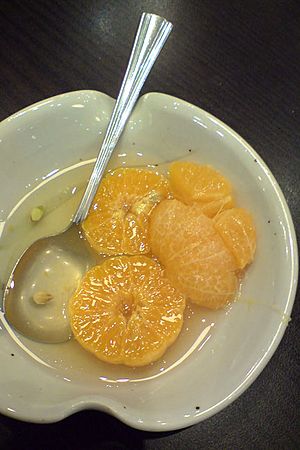
Eating Fresh Mandarins
Most people peel and eat mandarins fresh. The fresh fruit is also used in salads, desserts, and main dishes. You can easily find fresh mandarin juice and frozen juice concentrate in stores. The number of seeds in each segment can be different.
Using the Peel
The peel of the mandarin is also useful. You can use it fresh, whole, or grated as zest. It can also be dried to make chenpi, a type of dried citrus peel. The peel is used as a spice in cooking, baking, drinks, or even candy.
Canned Mandarins
When mandarins are canned, their white inner peel (pith) is removed first. If it's not removed, the segments would taste bitter. This is done using a special chemical process. First, the segments are put in hot water to loosen the skin. Then, they are soaked in a lye solution, which dissolves the white pith and membranes. Finally, the segments are rinsed many times with plain water.
After they are prepared, mandarin oranges are heated to remove any bacteria. This stops them from spoiling. Then, the oranges are put into airtight containers. Sometimes, vitamin C (ascorbic acid) is added. Canned mandarins are often used in salads, desserts, and baking.
Mandarins in Traditional Medicine
In traditional Chinese medicine, the dried peel of the mandarin fruit is used. It is believed to help with the body's energy, called ch'i. It is also used to help with bloating, improve digestion, and reduce phlegm. Mandarins have also been used in ayurveda, which is a traditional medicine system from India.
Where Mandarins Are Grown
| Tangerines, mandarins, clementines Top ten producers in 2007 (1000 tonnes) |
|
|---|---|
| 15,185 | |
| 1,974 | |
| 1,206 | |
| 1,066 | |
| 1,042 | |
| 778 | |
| 748 | |
| 744 | |
| 702 | |
| 670 | |
| 640 | |
| All other | 4,156 |
| World total | 27,869 |
| Source: UN Food & Agriculture Organisation (FAO), [1] |
|
Images for kids
See also
 In Spanish: Mandarino para niños
In Spanish: Mandarino para niños


